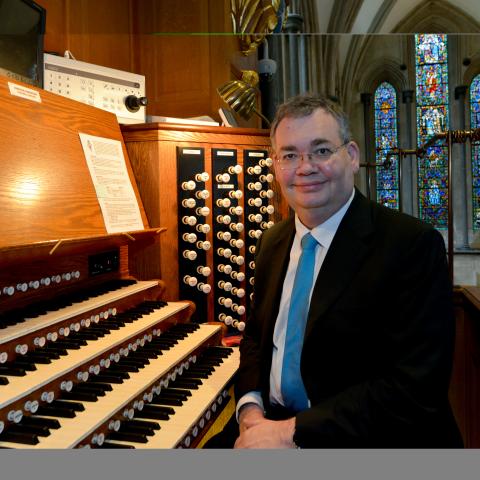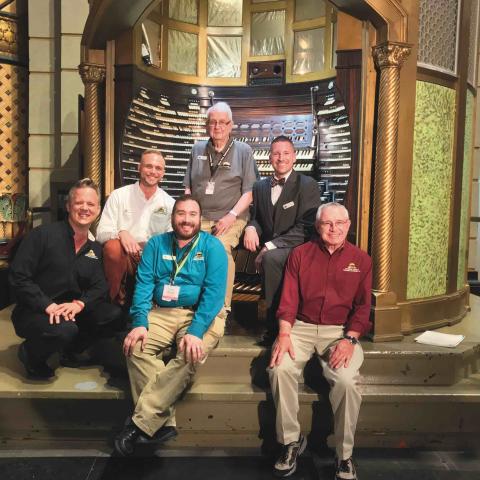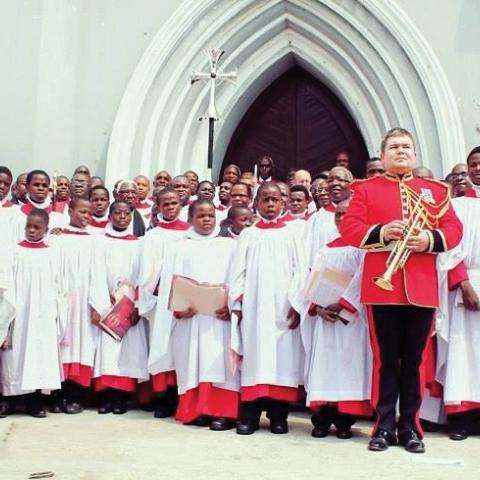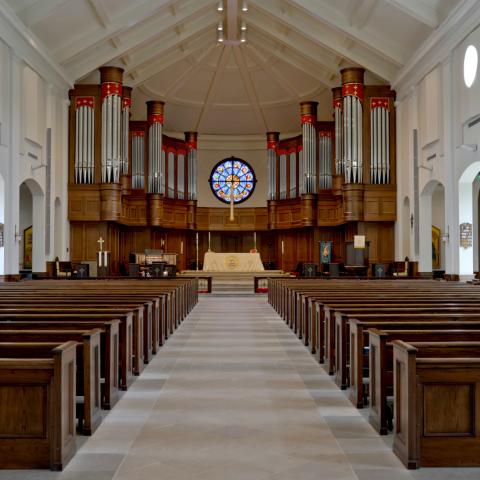Godwin Sadoh was a chorister at the Cathedral Church of Christ, Lagos, Nigeria, during the tenure of Charles Oluwole Obayomi Phillips in the 1980s. Sadoh received his early training in general musicianship, piano, organ, and composition from Phillips, who later appointed him as one of the cathedral organists. Sadoh is a Nigerian ethnomusicologist, composer, church musician, pianist, organist, choral conductor, and scholar with over 100 publications to his credit, including twelve books. His academic qualifications include a Master of Arts in ethnomusicology from the University of Pittsburgh, Master of Music in organ performance and church music from the University of Nebraska-Lincoln, and in 2004 at Louisiana State University, Baton Rouge, Sadoh distinguished himself as the first African to earn a doctoral degree in organ performance from any institution in the world.
His compositions have been performed and recorded around the globe. Sadoh is a former professor of music/LEADS Scholar at the National Universities Commission, Abuja, Nigeria. His biography is listed in Who’s Who in America, Who’s Who in American Education, and Who’s Who in the World.
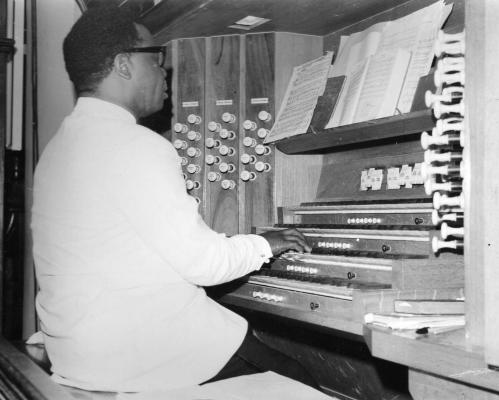
Which church is the oldest church in Nigeria?
The history of organ building in Nigeria closely follows the chronicle of Christian missions in the country. Christianity was fully established in Nigeria by the late nineteenth century with the influx of Anglican, Methodist, and Catholic missionaries from Europe, as well as Southern Baptist missionaries from the United States. Most of the missionary activities concentrated in the Yoruba southwest, Igbo southeast, and the Niger-Delta South-South regions of Nigeria. Various churches were built in these areas for new converts, where they were first introduced to the pipe organ.
Until the end of the twentieth century, the majority of pipe organs in Nigerian churches were built by British firms. The colonial administration and Christian missions inevitably encouraged transatlantic business engagements between England and Nigeria. Before long, Nigeria was flooded with products and goods made in Great Britain, including pipe organs. There are records of a few organs designed by German and Dutch firms in some Nigerian churches.1
Early organs
The evolution of organs in the Cathedral Church of Christ, Lagos, can be traced to 1853 when flutes and a harmonium were introduced to what was then Christ Parish Church by Reverend G. F. Beluah to enhance music during worship. Though Christianity was firmly established in Nigeria, singing in churches was still largely unknown at that time. The poor state of congregational singing could be attributed to the fact that music, especially hymns, was mainly in English, and British in style, construct, and culture. There was a lack of continuity between the traditional musical styles that the people were accustomed to and the new foreign music introduced by the missionaries.
Reverend Beluah, being one of the first missionaries sent to Nigeria by the Church Missionary Society in London, was well known for his patronage of classical church music. It was during his tenure that the first choir was organized at Christ Parish Church by Reverend Robert Coker, when the church was located at Oko-Faji, and the harmonium, which was a gift from a parishioner, Pa John Otunba Payne, served the church for several years.2
In 1867, Christ Church moved from its first site at Oko-Faji to a bigger edifice at its present location on Marina Street. The idea of purchasing a new organ to enhance music and worship in the new church gained momentum in the congregation, which by now had come to love church music. The church did not have a well-organized choir then; therefore, the congregation on Sundays relied on the harmonium to lead the singing of hymns. The pioneer work of Reverend Beluah rendered by introducing musical instruments was the genesis of several innovations that were to follow in the cathedral.
After Reverend Beluah’s tenure, Reverend N. T. Hamlyn, a Welshman, succeeded him as the new vicar in charge of the church, and he reorganized the choir of twenty-two singers. The women of the choir were replaced with boys, provided with surplices, and new choir stalls were erected at the east end of the church. It became necessary for the church to purchase a new organ to complement these changes and to meet the choral needs of a bigger congregation.3
Harrison & Harrison pipe organ
An order was placed in 1900 for a new pipe organ, the result of a successful campaign initiated by Reverend Hamlyn. Built by Harrison & Harrison in Durham, England, the new organ on arrival in Lagos was assembled within two weeks by the vicar himself. The instrument had one manual, five stops, and was noted for its very beautiful tone. It was widely admired by other parishes in Lagos. However, the new organ was short lived in Christ Church. The size of the congregation increased remarkably, and while the instrument served four organists, including Thomas Ekundayo Phillips,4 it soon proved inadequate. Thus, the acquisition of a bigger organ became inevitable for the fast-growing congregation.5
Harrison & Harrison reed organ
The year 1918 was historic at the Cathedral Church for several reasons. It witnessed the inauguration of the first choir festival in Nigeria. Also a new reed organ with two manuals and twenty-one stops, costing £247 was purchased and was dedicated on August 17 by Bishop Isaac Oluwole. This organ had no equal in West Africa, and, at that time, Christ Church was already a pro-cathedral and moving towards becoming a full-fledged cathedral. It was apparent that by the time the new cathedral building would be completed, the reed organ would be inadequate to meet the demands and requirements of a cathedral.
After due consideration, the parochial committee decided that the cathedral had to be provided with an organ that would befit its magnificence and status in the diocese. It took a long time to raise funds for the proposed organ, which was estimated to cost £2,885.6
Abbott & Smith organ
In 1932, the newly established cathedral ordered a new and bigger pipe organ with three manuals and 1,280 pipes costing £3,000. The organbuilder, Abbott & Smith of Leeds, England, installed the instrument in the choir section of the cathedral. It was dedicated by Bishop F. Melvine Jones. Interestingly, the organ served the cathedral for seventy-seven years.7
The specification of the organ was drawn by Ekundayo Phillips in consultation with the builders. The inaugural recital played by Phillips on April 17, 1932, comprised the following pieces:
Meditation in a Cathedral—E. Silas
First movement, Sonata No. 6—Felix Mendelssohn
Gloria in Excelsis—Wolfgang Amadeus Mozart
Prière et Berceuse—Felix Alexandre Guilmant
Hosanna (chorus magnum)—Theodore Dubois.
Abbott & Smith organ
GREAT
16′ Double Open Diapason
8′ Large Open Diapason
8′ Small Open Diapason
8′ Claribel Flute
8′ Dolce
4′ Principal
2′ Fifteenth
SWELL
8′ Violin Diapason
8′ Lieblich Gedackt
8′ Echo Gamba
8′ Vox Celeste
4′ Gemshorn
4′ Harmonic Flute
8′ Horn
8′ Oboe
CHOIR
8′ Dulciana
8′ Rohrflute
8′ Viol d’Orchestre
4′ Lieblich Flute
8′ Clarinet
PEDAL
32′ Harmonic Bass
16′ Open Diapason (metal)
16′ Bourdon (wood)
8′ Bass Flute
In 1954, the organ was enlarged by William Hill & Son & Norman & Beard, Ltd., Norfolk, England. This project was recommended by Thomas Ekundayo Phillips, with the aim of increasing the brilliance and power of the organ, especially for leading the large congregation in worship. This rebuilt instrument featured 1,661 pipes. The following stops were added:8
GREAT
4′ Wald Flute
II Quartane
8′ Trumpet
4′ Clarion
SWELL
16′ Contra Fagotto
CHOIR
8′ Diapason Cantabile
8′ Trumpet (from Great)
PEDAL
16′ Trombone
By 1964, a thorough rebuilding of the organ was long overdue, and it was decided that the instrument should be completely modernized. A contract for the work was signed with Bernard Pels & Zn. N. V. of Alkmaar, the Netherlands. The specification was drawn by Kenneth Jones in consultation with Thomas Ekundayo Phillips and his son, Charles Oluwole Obayomi Phillips, who became organist and master of the music of the cathedral upon his father’s retirement in 1962.9
The organ committee and builders agreed to incorporate almost all pipes of the old organ and the slider chests of the Great, Swell, and Choir divisions, reducing the cost of the new organ. In addition, the case and façade of the old organ were retained with one change—the congregation would now see the pipes of the Pedal 16′ Open Diapason on the side of the organ, in the south transept, where previously there were dummy pipes.
A new console, action, blowers, reservoirs, and some chests with new pipes were provided. The system of action used was all electric, proving to be most reliable in the tropical climate of Lagos, eliminating the myriad of small pieces of leather that were the major cause of maintenance difficulties in the old organ.
An eclectic specification was drawn, recognizing the nature of the stops retained from the old organ and the overall limit on the size of the new one. Each division was provided a complete chorus, with the exception of the flue stops of the solo portion of the Choir-Solo organ. The Great organ diapason chorus was now complete, and the richness and brilliance of this division was enhanced by the IV–VI Mixture. In the Swell, the traditional full Swell effect was provided with reeds at 16′, 8′, and 4′ pitches, as well as a mixture. The enclosed Choir organ featured a miniature chorus. The solo division flues could be used for accompaniment. With the II–III Sesquialtera, interesting tone colors were available for solo use. The high-pressure reeds of the Solo division were in effect a Bombarde organ of considerable power. The 8′ Orchestral Trumpet alone could be used against the full Great stops.
The Positif division was designed on classical lines and voiced accordingly. It had an admirable clarity, and quite apart from its accompaniment role and solo possibilities was of value in playing works from the Baroque period. The Pedal division was complete in itself. A full range of couplers was provided so that, with discretion, maximum use could be made of all the stops of the organ. For the accompaniment of the choir, the new organ contained all that was required for the tradition of Anglican service music. Suitable registration was available for performance of all organ music from the Baroque period to the twentieth century. Perhaps most importantly, there was more adequate variety and power for the largest congregation in Lagos.10
Bernard Pels & Zn. N. V. organ
GREAT (Manual II)
16′ Double Open Diapason
8′ Large Open Diapason
8′ Small Open Diapason
8′ Claribel Flute
4′ Principal
4′ Wald Flute
2-2⁄3′ Twelfth
2′ Fifteenth
IV–VI Mixture
8′ Trumpet
4′ Clarion
Great Octave
Swell Suboctave to Great
Swell to Great
Swell Octave to Great
Choir/Solo Suboctave to Great
Choir/Solo to Great
Choir/Solo Octave to Great
Positif to Great
SWELL (Manual III, enclosed)
8′ Violin Diapason
8′ Lieblich Gedackt
8′ Echo Gamba
8′ Vox Celeste
4′ Gemshorn
II Quartane
16′ Contra Fagotto
8′ Horn
4′ Schalmey
Tremulant
Swell Suboctave
Swell Octave
Positif to Swell
CHOIR/SOLO (Manual I)
enclosed:
8′ Rohrflute
8′ Viol D’Orchestre
4′ Principal
2′ Piccolo
8′ Clarinet
unenclosed:
8′ Diapason
8′ Dolce
4′ Blockflute
II–III Sesquialtera
16′ Contra Trumpet
8′ Orchestral Trumpet
4′ Orchestral Clarion
Tremulant
Choir/Solo Suboctave
Choir/Solo Octave
Swell to Choir/Solo
Positif to Choir/Solo
POSITIF (Manual IV)
8′ Spitzflute
8′ Chimney Flute
4′ Prestant
2′ Nachthorn
1-1⁄3′ Nazard
IV Scharf
8′ Cromorne
PEDAL
32′ Harmonic Bass
16′ Open Diapason
16′ Bourdon
8′ Octave Bass
8′ Bass Flute
4′ Choral Bass
IV Mixture
16′ Trombone
8′ Trumpet
Tremulant
Great to Pedal
Swell to Pedal
Choir/Solo Pedal
Positif to Pedal
A new organ for the twenty-first century
The 1964 organ served the church for nearly forty-four years, by which time the Cathedral Church had come to realize that the organ would not sustain the musical activities of the church in the twenty-first century. The congregation began a campaign to procure the present four-manual organ. The idea of a new organ was conceived by the Women’s Guild Auxiliary of the Cathedral Church, and a committee was established to achieve that purpose.
While the Women’s Guild Auxiliary was able to raise some money, the funds could only cover the first installments for the purchase of the organ. The Cathedral Standing Committee stepped forward, and an organ fund sub-committee was inaugurated in 2006 to raise the proposed amount of 164 million Naira (US$1,640,000) from far and near. Members of the Cathedral Church, societies, families, individuals, the choir, and friends of the congregation were enjoined to participate in funding the new organ. Several campaigns and concerts to raise money ensued for the new instrument.11
Just as with the 1932 organ, the names of every donor who gave over two million Naira were to be engraved conspicuously on the panels of the new organ. On Sunday, January 20, 2008, the provost of the cathedral, the Very Reverend Yinka Omololu, announced to the congregation that they had realized the financial goal. This was made possible through the generous donations of the cathedral congregation and others from all over the country and around the world. At this stage, the 1964 organ was practically unplayable. Hence, during the period between the dismantling of the old organ and the installation of the new organ, a three-manual digital Rodgers organ was purchased and installed.
New Oberlinger organ
The installation of the new organ began on January 9, 2009. The old organ, which had served the church for well over seventy years, saw its last major services in 2008 at the choir’s ninetieth anniversary celebration and the Advent and Christmas carol services. Built by Oberlinger of Germany, the “New Oberlinger Organ” as named by worshippers in the cathedral has sixty-four stops and 3,700 pipes. It is supported on a steel structure built into the wall behind the choir section of the church to balance its heavy weight. The organ was dedicated at a special service on Sunday, May 9, 2010, and Thorsten Mader played the inaugural recital.12
Toccata and Fugue in D Minor—J. S. Bach
Fanfare, Cantabile, and Finale—Jacques-Nicolas Lemmens
“Litanies” from Trois Pièces—Jehan Ariste Alain
Joshua Fit de Battle of Jericho—Fela Sowande
Symphony No. 5—Charles-Marie Widor
Oberlinger Orgelbau, GmbH
GREAT (Manual II)
16′ Double Diapason
8′ Open Diapason
8′ Flute Harmonique
8′ Chimney Flute
8′ Gamba
4′ Octave
4′ Gemshorn
2-2⁄3′ Quint
2′ Super Octave
2′ Mixture V
1′ Cymbale IV
16′ Double Trumpet
8′ Trumpet
4′ Clairon
Great 16
SWELL (Manual IV, enclosed)
16′ Bourdon
8′ Open Diapason
8′ Double Flute
8′ Viole de Orchestre
8′ Vox Coelestis
4′ Principal
4′ Flute Octaviante
2′ Octavin
2-2⁄3′ Mixture IV–V
16′ Basson
8′ Trompette Harmonique
8′ Hautbois
4′ Clairon Harmonique
Tremolo
Swell 16
Swell 4
CHOIR (Manual III)
16′ Quintade
8′ Violin Diapason
8′ Lieblich Gedackt
8′ Quintade
4′ Principal
4′ Lieblich Flute
2-2⁄3′ Twelfth
2′ Piccolo
1-3⁄5′ Terz
1-1⁄3′ Larigot
1-1⁄3′ Plein Jeu V
16′ Contra Cromorne
8′ Schalmey
8′ Cromorne
4′ Schalmey
Tremolo
Choir 16
Choir 4
ANTIPHONAL (Manual I)
16′ Claribel Flute
8′ Flute
4′ Soprano Flute
16′ Trompeta Magna
8′ Trompeta da Batalla
4′ Banjoncillo
2′ Clarin Brilliante
PEDAL
32′ Bourdon
16′ Open Diapason
16′ Violone
16′ Sub Bass
16′ Zart Bass
8′ Octave
8′ Cello
8′ Bass Flute
4′ Choral Bass
4′ Flute
32′ Bombarde
16′ Trombone
16′ Basson
8′ Trombone
Couplers
IV–P
III–P
IV–III
III–II 16
III–II
III–II 4
IV–II
II–I 16
II–I
II–I 4
III–I 16
III–I
IV–I
The present organ is used in accompanying traditional hymns, liturgical music, cantatas, oratorios, contemporary praise choruses, and playing recitals. The praise choruses are often sung during celebratory moments in worship, such as baby naming ceremonies, as well as wedding and birthday anniversaries. The Cathedral Choir, of course, leads the congregation in singing.13
Notes
1. Godwin Sadoh, The Centenary of the Cathedral Church of Christ Choir, Lagos (Columbus, Ohio: GSS Publications, 2018), 35–36.
2. Sadoh, 36.
3. Sadoh, 37.
4. Thomas Ekundayo Phillips was organist and master of the music at the Cathedral Church of Christ, 1914–1962.
5. Sadoh, 37–38.
6. Sadoh, 38.
7. Sadoh, 38–39.
8. Sadoh, 41.
9. Charles Oluwole Obayomi Phillips served the cathedral church as organist and master of the music, 1962–1992.
10. Sadoh, 42–44.
11. Sadoh, 48–49.
12. Sadoh, 50.
13. This article is extracted from Godwin Sadoh’s book, The Centenary of the Cathedral Church of Christ Choir, Lagos (Columbus, Ohio: GSS Publications, 2018), 35–63.
Photo:
Charles Oluwole Obayomi Phillips at the 1964 organ console

